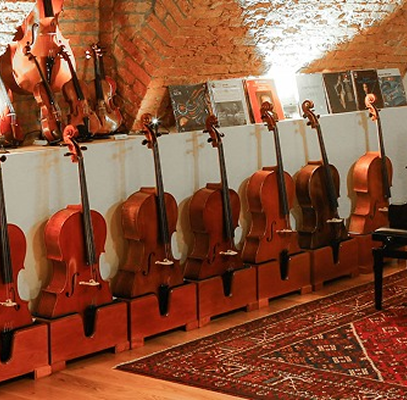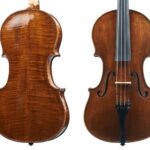How to Choose the Right Violin Strings
Back to BlogHow to Choose the Right Violin Strings — Gut, Synthetic, Steel, And Plated E-Strings
Have you ever asked yourself how two violins can sound worlds apart, even when the same artist plays them? Usually, the reason behind this is something small but mighty: the strings. Deciding on the finest violin strings isn’t just a matter of quality but finding tone, tension, and feel that match your playing style. From deep, warm gut to bright, aggressive steel and all points in between, the appropriate set of strings can have a drastic impact on your sound while improving your performance.
Understanding String Types And Sound Qualities
Gut Strings — Rich History, Richer Sound
Gut strings have been around since the Baroque era and were once the standard for all violinists. They are famous for their warm, textured, and complex tone — they provide you with a rich palette of expression that blends beautifully in solo repertoire and period ensembles. However, they’re not without challenges. Gut strings are more sensitive to humidity and temperature, thus leading to frequent tuning and shorter lifespans. If you want authenticity or tonal warmth above all else, gut may still be among the best violin strings, especially for historically informed performances.
Synthetic-Core Strings — The Modern Middle Ground
Synthetic-core strings bridge the gap between gut and steel. They offer a warm, rounded tone similar to gut but with improved stability and longer life. These strings hold tuning better and settle quickly after installation, making them a popular choice for advanced artists. Types like Dominant, Obligato, and Vision dominate this category, favored by orchestral and chamber musicians alike. If you’re looking for flexibility, comfort, and versatility, synthetic-core options are strong contenders among the best violin strings available today.
Steel-Core Strings — Bright, Durable, Reliable
Steel-core strings are known for their bright, direct sound and excellent tuning stability. Furthermore, they’re incredibly durable, making them a go-to for beginners and electric violin players who need consistency and longevity. While they may lack the tonal complexity of gut or synthetic-core strings, steel options excel in clarity and projection. If you are looking for power, precision, and low maintenance, they’re often considered the best violin strings for high-use environments like teaching studios or amplified settings.
E-Strings Explained — Plated, Steel, And Alternatives
Plating Options
E-strings are presented in several types of finishes, with each affecting sound and feel. Tin-plated steel is a bright, economical option that responds quickly. Plain steel E-strings produce a clear, uncolored sound and are popular with players who prefer less interference. For more richness of sound, gold-plated E-strings are warmer and smoother under the finger but can corrode more quickly. Aluminum-wound vesions lessen harshness and whistle less. Selecting optimal violin strings usually starts with determining which E-string material suits your tone and playing technique.
Tone Tradeoffs
Each type of E-string has varying advantages and disadvantages. Tin- and steel-plated ones are bright and concentrated in sound but harsh to sensitive ears. Gold and aluminum produce warmth and soften the bite, but wear down faster or are more expensive. A few E-strings also come with protective ball ends or loop ends, and these will influence how they fit your tailpiece. When looking for balance and flexibility, tone weight, durability, and response are important considerations in choosing the most suitable violin strings for your playing style.
Smart Pairings
Most violinists will change only their E-string so that the rest of their setup feels more alike. For instance, coupling a gold-plated E-string with a synthetic-core set (such as Dominant or Obligato) brings sparkle and definition to a rich, dark sound. Some may prefer a plain steel E for attack in fast passages. Since E-strings can make or break high-register sound, these bespoke combinations frequently produce an even more refined and expressive voice, just what you’d hope to get from the finest violin strings on the market today.
Player Fit
The E-string is a matter of personal preference—it has to fit your instrument, bow pressure, and musical requirements. A soloist may prefer a strong, projecting E that can cut through an orchestra, but a chamber player may want softness and warmth.
It’s not a matter of cost or material—it’s a matter of the delicate interplay between player and string. To determine the most suitable violin strings for your requirements, it’s essential to listen attentively and take note of how each E-string sounds and plays in real performance circumstances.
Essential Aspects When Choosing Strings
Tension And Gauge
Learning About String Tension
Violin strings are available in light, medium, and heavy tensions, all of which influence your instrument’s tone and playability. Light tension strings provide playability and fast articulation, with heavy strings bringing deeper tone and increased volume, which is well-suited to players with a firm bow arm.
Tradeoffs in Sound and Feel
Heavier strings tend to be more projective and have a darker sound, but they take more pressure and tend to tire out lighter instruments. Lighter strings are responsive but can be thin. Medium gauge is best balanced, particularly for overall use.
Finding the Right Fit
When purchasing a violin in-store or online, it is essential to balance string tension with bowing style and favorite repertoire. Soloists could prefer higher tension for projection, with light string users in orchestral or folk contexts preferring lighter strings for ease and agility.
Environmental Sensitivity
Gut Versus Synthetic Endurance
Temperature and humidity will have a drastic impact on string playing, especially on gut-core options. Gut strings are famous for their sonic beauty but stretch and slide in changing climates and so are less ideally suited to travel or outdoor performance.
Playing Conditions Matter
If you’re playing in air-conditioned concert halls one day and damp practice rooms the next, synthetic-core strings provide greater tuning stability and longevity. Steel-core strings remain more weather-resistant, an astute choice for touring performers.
Longevity and Performance
Exposure to moisture over time can lead to corrosion, fraying, or loss of tone. For this purpose, musicians who are looking for how to choose a violin must also consider their playing conditions and immediate environment. Durable, climate-proof strings will make your sound consistent and dependable.
Popular String Sets And Brands
Best String Brands to Familiarize Yourself With
When it comes to quality violin strings, some names always rise to the top. Names like Thomastik-Infeld, Pirastro, and Larsen are well-known around the world to violins of every skill level. These brands provide superior consistency, tonal range, and reliability, whether you’re a beginner or play professionally.
Tone and Play Style
Each set has its own individual voice. Dominants are warm and pliable, with Evah Pirazzi adding power and light for solo work. Larsen strings are clear and full, and are most suitable for lyrical playing. Obligato leans toward warmth and delicacy, and Zyex is praised for quick response and long life.
Mixing And Upgrading Strings
Several professionals mix sets—like pairing a gold-plated E-string with a synthetic-core G-D-A—for personalized results. For those seeking quality violins available for purchase, buying expensive violin brands and high-quality strings is one and the same. However, low-priced sets still offer a decent tone for student learners to build upon.
How to Experiment And Find Your Best Fit
Discovering the best violin strings might be a process, not a single purchase. Experimenting with different sets over time, particularly using sampler packs or temporary trials, can assist in discovering what really works for your instrument and playing style. Violin shop or workshop consultation services can also limit your options effectively. Don’t hesitate to consult your teacher or a trusted luthier since they can give insight based on your tone, bowing, and ambitions. Take notes on how each set feels and sounds, and switch strings based on genre or setting. Tinkering with little things can result in monumental breakthroughs in sound.
String Maintenance And Care Tips
To achieve the best out of the top violin strings, maintenance is crucial. Synthetics and steels typically last 3–6 months with heavy playing, whereas gut strings need to be replaced earlier. Keep an eye out for fraying, slipping, dull sound, or difficulty in staying in tune — these typically indicate it’s time for a new set. Clean your strings after each playing session to avoid the accumulation of rosin and corrosion. Refrain from touching them with oily fingers, and keep your violin in a dry, stable place. Altering strings one at a time preserves the alignment of the bridge and maintains your tone stable.
Conclusion
The best violin strings aren’t a matter of one-size-fits-all—rather, they’re based on your instrument, technique, and artistic objectives. Invest time to try out, discover, and listen. Furthermore, if you want personalized advice and expert direction, reach out to Amorim Fine Violins and we will be happy to help!









